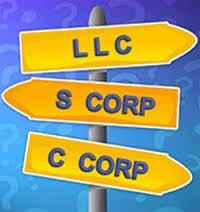Starting a Business – Structure

Over the next few weeks, I will be posting a series of articles on starting a business. The focus will be on structure, tools, processes and mistakes to avoid.
 This week I will focus on structure.
Every business essentially has three possible forms of structure, with variations on the types.
This week I will focus on structure.
Every business essentially has three possible forms of structure, with variations on the types.
Sole Proprietor
-
- Sole Proprietor: Many businesses start with this structure. In other words you have a good idea and you start it yourself. According to Entrepreneur Magazine,"The sole proprietorship is the simplest business form under which one can operate a business. The sole proprietorship is not a legal entity. It simply refers to a person who owns the business and is personally responsible for its debts." You can use your name or file for a fictitious business name, which is sometimes called a DBA or "Doing Business As" name. This does not change the structure. You are still responsible for everything, debt, and liabilities. The good thing is it is simple and the bad thing is you have no protection from bad things happening to the company.
A Partnership
-
- A Partnership: This is a step above a sole proprietorship, however many times liabilities are shared, but if one partner does not have means, the other partner can become liable for everything, ultimately, BBES does not recommend partnerships. I see little attractiveness and a corporation can handle any agreement that a partnership encompasses.There is a structure named Limited Liability Partnership (LLP). Partnerships allow direct management versus a corporation which has a BoD, however with closely held corporations this is a difference without a significance. LLP are usually associated with Lawyers, accountants, and architects. I would take great care in any LLP that I was asked to join.
Corporations
- Corporations: These come in many shapes and sizes, however, for our purposes, the two major corporations are C and S corporations. These titles come with the IRS tax code that defines their properties. There also exists and Limited Liability Corporation.
C corporation
-
- A C corporation's major significance is that the corporation is taxed separately from its owners (shareholders). Also since the corporation is a separate legal entity, liability remains with the corporation. Profit takes from a C corporation in dividends. The most significant drawback is the double taxation. The corporation must pay taxes on profits and the shareholders will pay taxes on any dividends received. C Corporations can have an unlimited number of shareholders and they can have different classes of shares. They can also deduct almost any kind of expense as long as can be demonstrated as relating to the business and off course it is not for illegal activities.
S corporation
- An S corporation is a special corporation that passes corporate income losses, deductions, and credits through to their shareholders. This avoids the double taxation, however, this type of corporation has some limitations. As with all corporations, the advantage of protection from liability exists. An S Corporation can only have one class of stock and the number of shareholders is limited. In some circles, it is believed S Corporations get audited more frequently, however that is not my experience.
- Another Common entity is a Limited Liability Corporation. It is very similar to an S Corp. However, there are no limits on the number of members and you can have managing members and non-managing members. Limited Liability corporations may also have restrictions on selling membership whereas S corp shares can be freely traded.
-

Comment (2)
where to buy rybelsus| May 27, 2025
[…] rybelsus pills […]
clomid 50mg tablets| June 2, 2025
[…] clomid without insurance generic […]